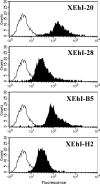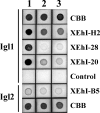Characterization of Entamoeba histolytica intermediate subunit lectin-specific human monoclonal antibodies generated in transgenic mice expressing human immunoglobulin loci
- PMID: 19001071
- PMCID: PMC2612286
- DOI: 10.1128/IAI.01002-08
Characterization of Entamoeba histolytica intermediate subunit lectin-specific human monoclonal antibodies generated in transgenic mice expressing human immunoglobulin loci
Abstract
Four fully human monoclonal antibodies (MAbs) to Entamoeba histolytica intermediate subunit lectin (Igl) were prepared in XenoMouse mice, which are transgenic mice expressing human immunoglobulin loci. Examination of the reactivities of these MAbs to recombinant Igl1 and Igl2 of E. histolytica showed that XEhI-20 {immunoglobulin G2(kappa) [IgG2(kappa)]} and XEhI-28 [IgG2(kappa)] were specific to Igl1, XEhI-B5 [IgG2(kappa)] was specific to Igl2, and XEhI-H2 [IgM(kappa)] was reactive with both Igls. Gene analyses revealed that the V(H) and V(L) germ lines were VH3-48 and L2 for XEhI-20, VH3-21 and L2 for XEhI-28, VH3-33 and B3 for XEhI-B5, and VH4-4 and A19 for XEhI-H2, respectively. Flow cytometry analyses showed that the epitopes recognized by all of these MAbs were located on the surfaces of living trophozoites. Confocal microscopy demonstrated that most Igl1 and Igl2 proteins were colocalized on the surface and in the cytoplasm, but different localization patterns in intracellular vacuoles were also present. The preincubation of trophozoites with XEhI-20, XEhI-B5, and XEhI-H2 caused significant inhibition of the adherence of trophozoites to Chinese hamster ovary cells, whereas preincubation with XEhI-28 did not do so. XEhI-20, XEhI-B5, and XEhI-H2 were injected intraperitoneally into hamsters 24 h prior to intrahepatic challenge with E. histolytica trophozoites. One week later, the mean abscess size in groups injected with one of the three MAbs was significantly smaller than that in controls injected with polyclonal IgG or IgM isolated from healthy humans. These results demonstrate that human MAbs to Igls may be applicable for immunoprophylaxis of amebiasis.
Figures







Similar articles
-
VH3 gene usage in neutralizing human antibodies specific for the Entamoeba histolytica Gal/GalNAc lectin heavy subunit.Infect Immun. 2003 Aug;71(8):4313-9. doi: 10.1128/IAI.71.8.4313-4319.2003. Infect Immun. 2003. PMID: 12874307 Free PMC article.
-
Identification of the Entamoeba histolytica galactose-inhibitable lectin epitopes recognized by human immunoglobulin A antibodies following cure of amebic liver abscess.Infect Immun. 2004 Jul;72(7):3974-80. doi: 10.1128/IAI.72.7.3974-3980.2004. Infect Immun. 2004. PMID: 15213142 Free PMC article.
-
Adherence-inhibitory intestinal immunoglobulin a antibody response in baboons elicited by use of a synthetic intranasal lectin-based amebiasis subunit vaccine.Infect Immun. 2007 Aug;75(8):3812-22. doi: 10.1128/IAI.00341-07. Epub 2007 May 25. Infect Immun. 2007. PMID: 17526742 Free PMC article.
-
Entamoeba histolytica: from adherence to enteropathy.J Infect Dis. 1989 Mar;159(3):420-9. doi: 10.1093/infdis/159.3.420. J Infect Dis. 1989. PMID: 2536786 Review.
-
Antigenicity, immunogenicity and vaccine efficacy of the galactose-specific adherence protein of Entamoeba histolytica.Vaccine. 1993;11(2):241-6. doi: 10.1016/0264-410x(93)90024-r. Vaccine. 1993. PMID: 8438621 Review.
Cited by
-
Identification of Multiple Domains of Entamoeba histolytica Intermediate Subunit Lectin-1 with Hemolytic and Cytotoxic Activities.Int J Mol Sci. 2022 Jul 12;23(14):7700. doi: 10.3390/ijms23147700. Int J Mol Sci. 2022. PMID: 35887043 Free PMC article.
-
Comparison of hemolytic activity of the intermediate subunit of Entamoeba histolytica and Entamoeba dispar lectins.PLoS One. 2017 Jul 27;12(7):e0181864. doi: 10.1371/journal.pone.0181864. eCollection 2017. PLoS One. 2017. PMID: 28750000 Free PMC article.
-
Novel hemagglutinating, hemolytic and cytotoxic activities of the intermediate subunit of Entamoeba histolytica lectin.Sci Rep. 2015 Sep 10;5:13901. doi: 10.1038/srep13901. Sci Rep. 2015. PMID: 26354528 Free PMC article.
-
Evaluation of the C-Terminal Fragment of Entamoeba histolytica Gal/GalNAc Lectin Intermediate Subunit as a Vaccine Candidate against Amebic Liver Abscess.PLoS Negl Trop Dis. 2016 Jan 29;10(1):e0004419. doi: 10.1371/journal.pntd.0004419. eCollection 2016 Jan. PLoS Negl Trop Dis. 2016. PMID: 26824828 Free PMC article.
-
Filamentation initiated by Cas2 and its association with the acquisition process in cells.Int J Oral Sci. 2019 Oct 3;11(3):29. doi: 10.1038/s41368-019-0063-0. Int J Oral Sci. 2019. PMID: 31578319 Free PMC article.
References
-
- Abadi, J., J. Friedman, R. A. Mageed, R. Jefferis, M. C. Rodriguez-Barradas, and L. Pirofski. 1998. Human antibodies elicited by a pneumococcal vaccine express idiotypic determinants indicative of V(H)3 gene segment usage. J. Infect. Dis. 178707-716. - PubMed
-
- Andris, J. S., P. H. Ehrlich, L. Ostberg, and J. D. Capra. 1992. Probing the human antibody repertoire to exogenous antigens. Characterization of the H and L chain V region gene segments from anti-hepatitis B virus antibodies. J. Immunol. 1494053-4059. - PubMed
-
- Bekker, P. J., D. L. Holloway, A. S. Rasmussen, R. Murphy, S. W. Martin, P. T. Leese, G. B. Holmes, C. R. Dunstan, and A. M. DePaoli. 2004. A single-dose placebo-controlled study of AMG 162, a fully human monoclonal antibody to RANKL, in postmenopausal women. J. Bone Miner. Res. 191059-1066. - PubMed
-
- Bird, R. E., K. D. Hardman, J. W. Jacobson, S. Johnson, B. M. Kaufman, S. M. Lee, T. Lee, S. H. Pope, G. S. Riordan, and M. Whitlow. 1988. Single-chain antigen-binding proteins. Science 242423-426. - PubMed
Publication types
MeSH terms
Substances
Associated data
- Actions
- Actions
- Actions
- Actions
- Actions
- Actions
- Actions
- Actions
LinkOut - more resources
Full Text Sources
Molecular Biology Databases
Research Materials

